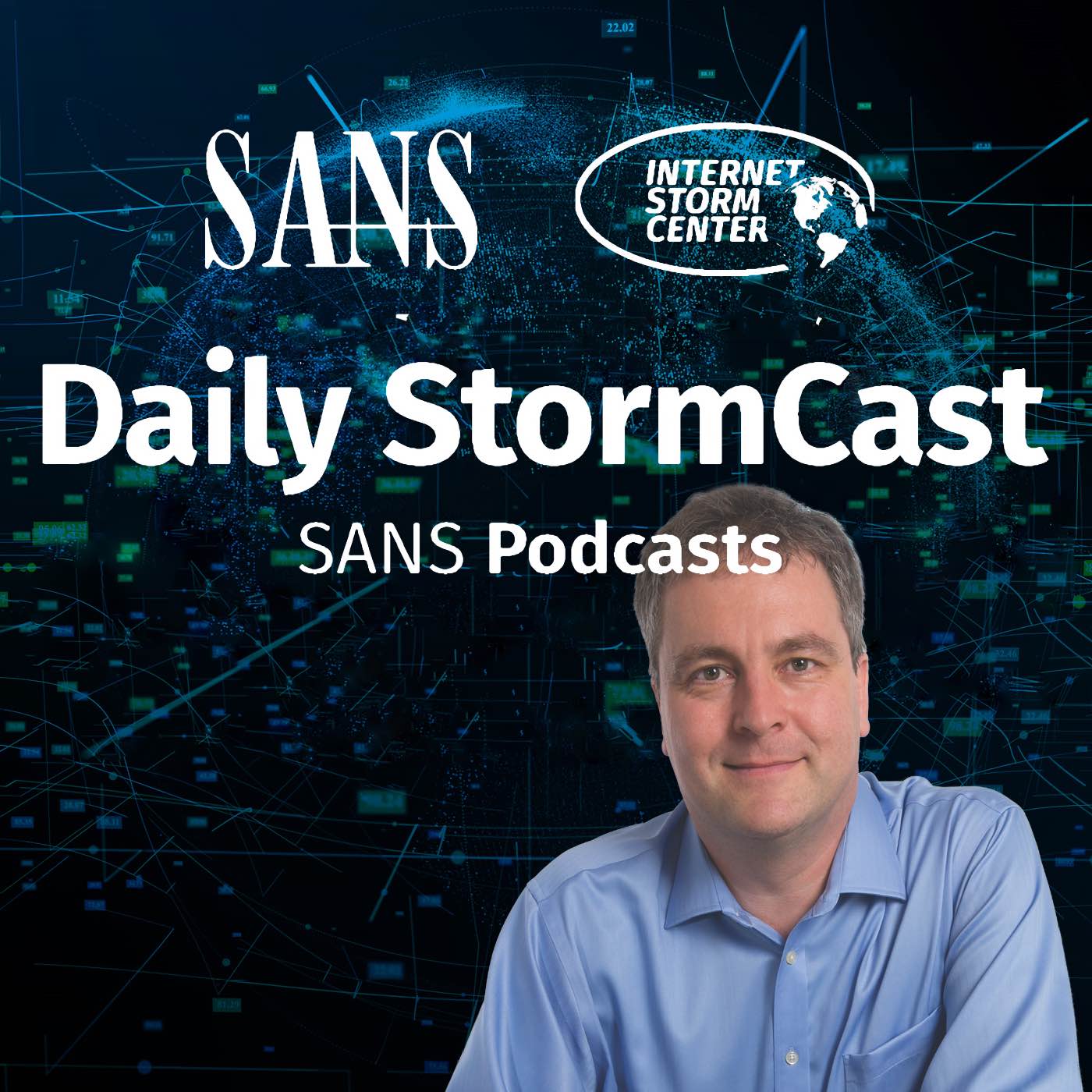Handler on Duty: Didier Stevens
Threat Level: green
Podcast Detail
SANS Stormcast Friday, April 18th: Remnux Cloud Environment; Erlang/OTP SSH Vuln; Brickstorm Backdoor Analysis; GPT 4.1 Safety Controversy
If you are not able to play the podcast using the player below: Use this direct link to the audio file: https://traffic.libsyn.com/securitypodcast/9414.mp3

Remnux Cloud Environment; Erlang/OTP SSH Vuln; Brickstorm Backdoor Analysis; GPT 4.1 Safety Controversy
00:00
My Next Class
| Application Security: Securing Web Apps, APIs, and Microservices | Orlando | Mar 29th - Apr 3rd 2026 |
| Network Monitoring and Threat Detection In-Depth | Amsterdam | Apr 20th - Apr 25th 2026 |
RedTail: Remnux and Malware Management
A description showing how to set up a malware analysis in the cloud with Remnux and Kasm. RedTail is a sample to illustrate how the environment can be used.
https://isc.sans.edu/diary/RedTail%2C%20Remnux%20and%20Malware%20Management%20%5BGuest%20Diary%5D/31868
Critical Erlang/OTP SSH Vulnerability
Researchers identified a critical vulnerability in the Erlang/OTP SSH library. Due to this vulnerability, SSH servers written in Erlang/OTP allow arbitrary remote code execution without prior authentication
https://www.openwall.com/lists/oss-security/2025/04/16/2
Brickstorm Analysis
An analysis of a recent instance of the Brickstorm backdoor. This backdoor used to be more known for infecting Linux systems, but now it also infects Windows.
https://www.nviso.eu/blog/nviso-analyzes-brickstorm-espionage-backdoor
https://blog.nviso.eu/wp-content/uploads/2025/04/NVISO-BRICKSTORM-Report.pdf
OpenAI GPT 4.1 Controversy
OpenAI released its latest model, GPT 4.1, without a safety report and guardrails to prevent malware creation.
https://opentools.ai/news/openai-stirs-controversy-with-gpt-41-release-lacking-safety-report
Discussion
New Discussions closed for all Podcasts older than two(2) weeks
Please send your comments to our Contact Form
| Application Security: Securing Web Apps, APIs, and Microservices | Orlando | Mar 29th - Apr 3rd 2026 |
| Network Monitoring and Threat Detection In-Depth | Amsterdam | Apr 20th - Apr 25th 2026 |
| Application Security: Securing Web Apps, APIs, and Microservices | San Diego | May 11th - May 16th 2026 |
| Network Monitoring and Threat Detection In-Depth | Online | Arabian Standard Time | Jun 20th - Jun 25th 2026 |
| Network Monitoring and Threat Detection In-Depth | Riyadh | Jun 20th - Jun 25th 2026 |
| Application Security: Securing Web Apps, APIs, and Microservices | Washington | Jul 13th - Jul 18th 2026 |
| Application Security: Securing Web Apps, APIs, and Microservices | Las Vegas | Sep 21st - Sep 26th 2026 |
Podcast Transcript
Hello and welcome to the Friday, April 18th, 2025 edition of the SANS Internet Storm Centers Stormcast. My name is Johannes Ullrich and today I'm recording from Orlando, Florida. Today we got another guest diary by one of our undercredit interns. Jacob Claycamp did write about how to get started in malware analysis. Of course, we have plenty of diaries always about malware analysis. Didier and Xavier most notably are heavily contributing to this. This is more the beginner's view of malware analysis and sort of how to get started with malware analysis using a cloud-based system. A couple of interesting parts here. First of all, Jacob is using AWS, a free instance, and then uses Chasm Workspace in order to essentially get a remote desktop into a container which then runs Remnux. This is Lenny Zeltzer's reverse analysis environment. All of this is Linux-based and since it is set up in a container, it's also easy to reset. And the cloud deployment, of course, makes it nice and isolated from anything that you may have going on in your home network. Overall, interesting setup. And then Jacob is going over a quick analysis of a redtail sample and how to apply this particular environment to the analysis of this particular malware. Interesting write-up and nice step-by-step guide to help you get started. And then we have a critical vulnerability affecting the Erlang OTP SSH library. This affects any SSH servers written in this language. The vulnerability was found by researchers at the Rue University in Bochum. Now, the OTP here in Erlang OTP does not stand for one-time password. Instead, it does stand for the Open Telecom Platform. This particular version of Erlang was created and maintained initially by Ericsson and is often used in telecom-related devices, routers and the like. So, certainly there is quite a number of affected devices out there. The CVSS score of the vulnerability is a perfect 10 .0 because it does allow for arbitrary code execution without authentication. The problem is that some SSH messages, some SSH protocol messages can be sent and executed before authentication finishes due to this bug. And that then leads to arbitrary code execution. Now, the user this code executes at depends on the user the SSH server is running at, at the time it receives these messages. Definitely upgrade, but of course, since this is a vulnerability in the library used to create the SSH server, you may have to wait for respective vendors to actually release updates here. In the meantime, the only alternative you have is to disable or firewall the SSH server. In Belgium, security company Inviso did release a report with details regarding some of their recent findings of the BrickStorm backdoor. BrickStorm has been used in Linux, in particular in sort of VMware environments, but now they also found a version of this backdoor on Windows. There are a couple interesting things to note here. Unlike most backdoors, this backdoor actually does not have a remote code execution capability. They say that typically RDP and such is used instead by the attacker and that they specifically didn't include a remote code execution capability to evade some heuristic and behavioral detection that you often find that would flag any code execution behavior. Instead, this particular backdoor is able to read, write files from the file system. It also has some network components that would allow an attacker to essentially use an affected system as a pivot to scan other systems in the network. So certainly a capable piece of malware. Also interesting as a command control channel, they're using Cloudflare workers and similar systems that again are less likely going to trigger alerts. Interesting report and it also includes some good indicators of compromise and ways and techniques how you can actually find if you are affected by this particular backdoor. And OpenAI released its latest greatest model, GPT 4.1, but this didn't happen amid some controversy around the security aspects here. First of all, this model was released without the usual safety reports or system cards, which typically outline how this particular model was created to be safe, meaning not, for example, allowing to create malware. Well, and apparently some of these safeguards that you often find in these models are missing from GPT 4.1, making it trivial to create malware with this model. Interesting problem here, and I'm not sure if this will be something that OpenAI will fix in short notice, but definitely we have seen malicious models, of course, before, but not from major vendors like OpenAI. Well, that is it for today. Well, that is it for today, so thanks again for listening, and thanks everybody who I met here, all of you listeners at the event here in Orlando, and we'll talk to you again on Monday. Bye.










